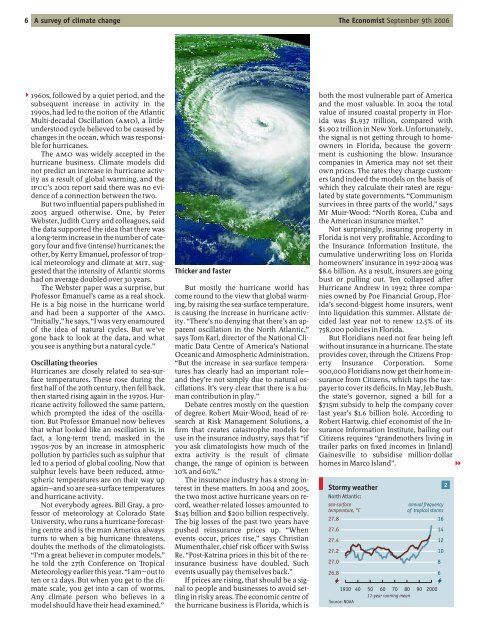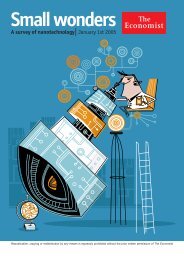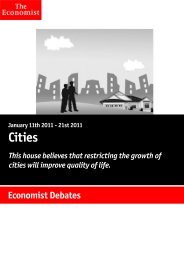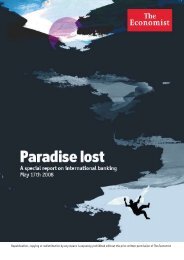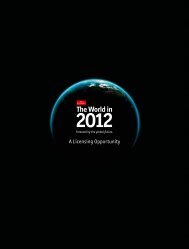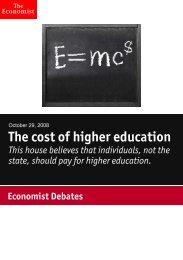You also want an ePaper? Increase the reach of your titles
YUMPU automatically turns print PDFs into web optimized ePapers that Google loves.
6 A survey of climate change <str<strong>on</strong>g>The</str<strong>on</strong>g> Ec<strong>on</strong>om<str<strong>on</strong>g>is</str<strong>on</strong>g>t September 9th 2006<br />
2 1960s, followed by a quiet period, and the<br />
subsequent increase in activity in the<br />
1990s, had led to the noti<strong>on</strong> of the Atlantic<br />
Multi-decadal Oscillati<strong>on</strong> (AMO), a littleunderstood<br />
cycle believed to be caused by<br />
changes in the ocean, which was resp<strong>on</strong>sible<br />
for hurricanes.<br />
<str<strong>on</strong>g>The</str<strong>on</strong>g> AMO was widely accepted in the<br />
hurricane business. Climate models did<br />
not predict an increase in hurricane activity<br />
as a result of global warming, and the<br />
IPCC’s 2001 report said there was no evidence<br />
of a c<strong>on</strong>necti<strong>on</strong> between the two.<br />
But two inuential papers publ<str<strong>on</strong>g>is</str<strong>on</strong>g>hed in<br />
2005 argued otherw<str<strong>on</strong>g>is</str<strong>on</strong>g>e. One, by Peter<br />
Webster, Judith Curry and colleagues, said<br />
the data supported the idea that there was<br />
a l<strong>on</strong>g-term increase in the number of category<br />
four and ve (intense) hurricanes; the<br />
other, by Kerry Emanuel, professor of tropical<br />
meteorology and climate at MIT, suggested<br />
that the intensity of Atlantic storms<br />
had <strong>on</strong> average doubled over 30 years.<br />
<str<strong>on</strong>g>The</str<strong>on</strong>g> Webster paper was a surpr<str<strong>on</strong>g>is</str<strong>on</strong>g>e, but<br />
Professor Emanuel’s came as a real shock.<br />
He <str<strong>on</strong>g>is</str<strong>on</strong>g> a big no<str<strong>on</strong>g>is</str<strong>on</strong>g>e in the hurricane world<br />
and had been a supporter of the AMO.<br />
Initially, he says, I was very enamoured<br />
of the idea of natural cycles. But we’ve<br />
g<strong>on</strong>e back to look at the data, and what<br />
you see <str<strong>on</strong>g>is</str<strong>on</strong>g> anything but a natural cycle.<br />
Oscillating theories<br />
Hurricanes are closely related to sea-surface<br />
temperatures. <str<strong>on</strong>g>The</str<strong>on</strong>g>se rose during the<br />
rst half of the 20th century, then fell back,<br />
then started r<str<strong>on</strong>g>is</str<strong>on</strong>g>ing again in the 1970s. Hurricane<br />
activity followed the same pattern,<br />
which prompted the idea of the oscillati<strong>on</strong>.<br />
But Professor Emanuel now believes<br />
that what looked like an oscillati<strong>on</strong> <str<strong>on</strong>g>is</str<strong>on</strong>g>, in<br />
fact, a l<strong>on</strong>g-term trend, masked in the<br />
1950s-70s by an increase in atmospheric<br />
polluti<strong>on</strong> by particles such as sulphur that<br />
led to a period of global cooling. Now that<br />
sulphur levels have been reduced, atmospheric<br />
temperatures are <strong>on</strong> their way up<br />
againand so are sea-surface temperatures<br />
and hurricane activity.<br />
Not everybody agrees. Bill Gray, a professor<br />
of meteorology at Colorado State<br />
University, who runs a hurricane-forecasting<br />
centre and <str<strong>on</strong>g>is</str<strong>on</strong>g> the man America always<br />
turns to when a big hurricane threatens,<br />
doubts the methods of the climatolog<str<strong>on</strong>g>is</str<strong>on</strong>g>ts.<br />
I’m a great believer in computer models,<br />
he told the 27th C<strong>on</strong>ference <strong>on</strong> Tropical<br />
Meteorology earlier th<str<strong>on</strong>g>is</str<strong>on</strong>g> year. I amout to<br />
ten or 12 days. But when you get to the climate<br />
scale, you get into a can of worms.<br />
Any climate pers<strong>on</strong> who believes in a<br />
model should have their head examined.<br />
Thicker and faster<br />
But mostly the hurricane world has<br />
come round to the view that global warming,<br />
by ra<str<strong>on</strong>g>is</str<strong>on</strong>g>ing the sea-surface temperature,<br />
<str<strong>on</strong>g>is</str<strong>on</strong>g> causing the increase in hurricane activity.<br />
<str<strong>on</strong>g>The</str<strong>on</strong>g>re’s no denying that there’s an apparent<br />
oscillati<strong>on</strong> in the North Atlantic,<br />
says Tom Karl, director of the Nati<strong>on</strong>al Climatic<br />
Data Centre of America’s Nati<strong>on</strong>al<br />
Oceanic and Atmospheric Admin<str<strong>on</strong>g>is</str<strong>on</strong>g>trati<strong>on</strong>.<br />
But the increase in sea-surface temperatures<br />
has clearly had an important role<br />
and they’re not simply due to natural oscillati<strong>on</strong>s.<br />
It’s very clear that there <str<strong>on</strong>g>is</str<strong>on</strong>g> a human<br />
c<strong>on</strong>tributi<strong>on</strong> in play.<br />
Debate centres mostly <strong>on</strong> the questi<strong>on</strong><br />
of degree. Robert Muir-Wood, head of research<br />
at R<str<strong>on</strong>g>is</str<strong>on</strong>g>k Management Soluti<strong>on</strong>s, a<br />
rm that creates catastrophe models for<br />
use in the insurance industry, says that if<br />
you ask climatolog<str<strong>on</strong>g>is</str<strong>on</strong>g>ts how much of the<br />
extra activity <str<strong>on</strong>g>is</str<strong>on</strong>g> the result of climate<br />
change, the range of opini<strong>on</strong> <str<strong>on</strong>g>is</str<strong>on</strong>g> between<br />
10% and 60%.<br />
<str<strong>on</strong>g>The</str<strong>on</strong>g> insurance industry has a str<strong>on</strong>g interest<br />
in these matters. In 2004 and 2005,<br />
the two most active hurricane years <strong>on</strong> record,<br />
weather-related losses amounted to<br />
$145 billi<strong>on</strong> and $200 billi<strong>on</strong> respectively.<br />
<str<strong>on</strong>g>The</str<strong>on</strong>g> big losses of the past two years have<br />
pushed reinsurance prices up. When<br />
events occur, prices r<str<strong>on</strong>g>is</str<strong>on</strong>g>e, says Chr<str<strong>on</strong>g>is</str<strong>on</strong>g>tian<br />
Mumenthaler, chief r<str<strong>on</strong>g>is</str<strong>on</strong>g>k ocer with Sw<str<strong>on</strong>g>is</str<strong>on</strong>g>s<br />
Re. Post-Katrina prices in th<str<strong>on</strong>g>is</str<strong>on</strong>g> bit of the reinsurance<br />
business have doubled. Such<br />
events usually pay themselves back.<br />
If prices are r<str<strong>on</strong>g>is</str<strong>on</strong>g>ing, that should be a signal<br />
to people and businesses to avoid settling<br />
in r<str<strong>on</strong>g>is</str<strong>on</strong>g>ky areas. <str<strong>on</strong>g>The</str<strong>on</strong>g> ec<strong>on</strong>omic centre of<br />
the hurricane business <str<strong>on</strong>g>is</str<strong>on</strong>g> Florida, which <str<strong>on</strong>g>is</str<strong>on</strong>g><br />
both the most vulnerable part of America<br />
and the most valuable. In 2004 the total<br />
value of insured coastal property in Florida<br />
was $1.937 trilli<strong>on</strong>, compared with<br />
$1.902 trilli<strong>on</strong> in New York. Unfortunately,<br />
the signal <str<strong>on</strong>g>is</str<strong>on</strong>g> not getting through to homeowners<br />
in Florida, because the government<br />
<str<strong>on</strong>g>is</str<strong>on</strong>g> cushi<strong>on</strong>ing the blow. Insurance<br />
companies in America may not set their<br />
own prices. <str<strong>on</strong>g>The</str<strong>on</strong>g> rates they charge customers<br />
(and indeed the models <strong>on</strong> the bas<str<strong>on</strong>g>is</str<strong>on</strong>g> of<br />
which they calculate their rates) are regulated<br />
by state governments. Commun<str<strong>on</strong>g>is</str<strong>on</strong>g>m<br />
survives in three parts of the world, says<br />
Mr Muir-Wood: North Korea, Cuba and<br />
the American insurance market.<br />
Not surpr<str<strong>on</strong>g>is</str<strong>on</strong>g>ingly, insuring property in<br />
Florida <str<strong>on</strong>g>is</str<strong>on</strong>g> not very protable. According to<br />
the Insurance Informati<strong>on</strong> Institute, the<br />
cumulative underwriting loss <strong>on</strong> Florida<br />
homeowners’ insurance in 1992-2004 was<br />
$8.6 billi<strong>on</strong>. As a result, insurers are going<br />
bust or pulling out. Ten collapsed after<br />
Hurricane Andrew in 1992; three companies<br />
owned by Poe Financial Group, Florida’s<br />
sec<strong>on</strong>d-biggest home insurers, went<br />
into liquidati<strong>on</strong> th<str<strong>on</strong>g>is</str<strong>on</strong>g> summer. Allstate decided<br />
last year not to renew 12.5% of its<br />
758,000 policies in Florida.<br />
But Floridians need not fear being left<br />
without insurance in a hurricane. <str<strong>on</strong>g>The</str<strong>on</strong>g> state<br />
provides cover, through the Citizens Property<br />
Insurance Corporati<strong>on</strong>. Some<br />
900,000 Floridians now get their home insurance<br />
from Citizens, which taps the taxpayer<br />
to cover its decits. In May, Jeb Bush,<br />
the state’s governor, signed a bill for a<br />
$715m subsidy to help the company cover<br />
last year’s $1.6 billi<strong>on</strong> hole. According to<br />
Robert Hartwig, chief ec<strong>on</strong>om<str<strong>on</strong>g>is</str<strong>on</strong>g>t of the Insurance<br />
Informati<strong>on</strong> Institute, bailing out<br />
Citizens requires grandmothers living in<br />
trailer parks <strong>on</strong> xed incomes in [inland]<br />
Gainesville to subsid<str<strong>on</strong>g>is</str<strong>on</strong>g>e milli<strong>on</strong>-dollar<br />
homes in Marco Island.<br />
1<br />
Stormy weather<br />
North Atlantic:<br />
sea-surface<br />
temperature, °C<br />
27.8<br />
27.6<br />
27.4<br />
27.2<br />
27.0<br />
26.8<br />
1930 40 50 60 70 80 90 2000<br />
11-year running mean<br />
Source: NOAA<br />
2<br />
annual frequency<br />
of tropical storms<br />
16<br />
14<br />
12<br />
10<br />
8<br />
6


